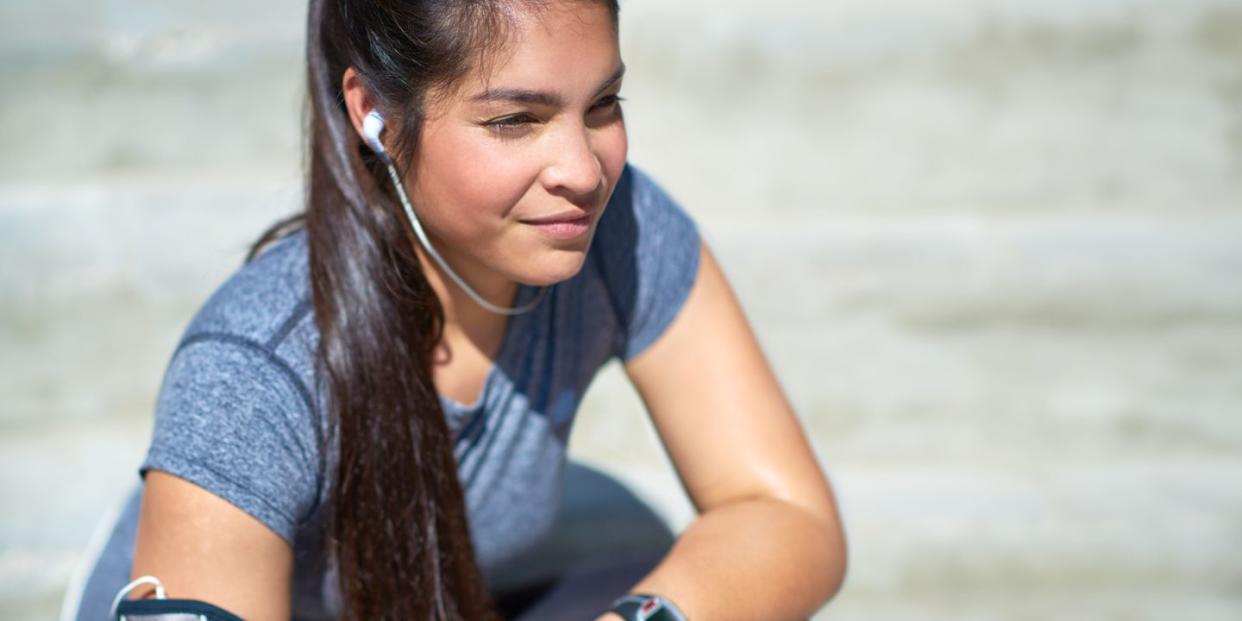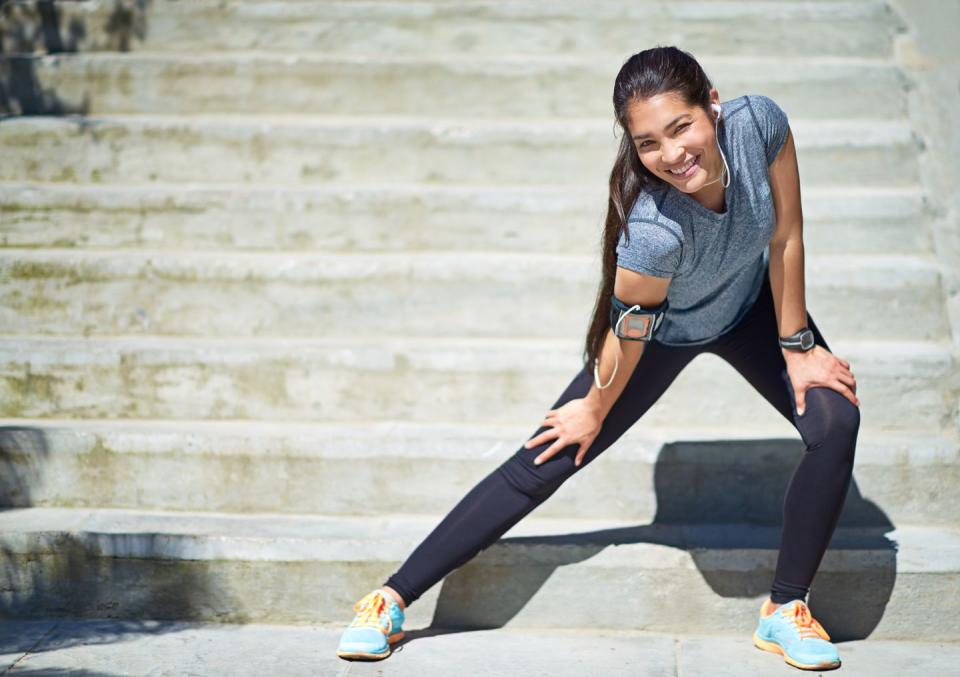BTW You Don't Have to Sweat Loads to Be Burning Calories

'No pain, no gain' as the saying goes, may be true in some respects. But if you want results in the gym - be that fat loss or building strength - there's a fine balance between flooding your body with stress hormones (hey, err, cortisol) and not pushing it enough.
There are some of us, however, who are probably more used to slumping up against the side of the gym on a "rest break" than using the workout data on the cardio kit, and could do with a with a brush-up on knowing whether we're putting in a quality session.
After all, raising your heart rate and fatiguing your muscles will get you the fitness results you're after - from toned abs to breaking that deadlift PB. Oh, and who doesn't love that post-workout buzz.
Read on to find out how to get that endorphin rush every time, the ways to know without a pro present if you're working out hard enough, and why feeling sick and sore muscles are not the aim. Phew.
[We earn a commission for products purchased through some links in this article.]
How much working out is enough?
For once it's personal. Any personal trainer will tell you that how much you need to train in a week depends on your body and goals. After a full-body tone up? Injured? Want to slim down to healthy body composition?
This means that the NHS guidelines should be taken as just that - a guide. They recommend adults between the ages of 16 and 64 years old should do both aerobic and strength exercises every week for optimum health.
More specifically they suggest doing one of the following...
At least 150 minutes of moderate aerobic activity such as cycling or brisk walking every week and strength exercises on 2 or more days a week that work all the major muscles (legs, hips, back, abdomen, chest, shoulders and arms).
At least 75 minutes of vigorous aerobic activity such as running or a game of singles tennis every week and the strength exercises (like above).
A mix of moderate and vigorous aerobic activity every week – for example, 2 x 30-minute runs plus 30 minutes of brisk walking equates to 150 minutes of moderate aerobic activity and strength exercises (ditto).
Is sweating a sign of a good workout?
The age old question - but one we're still confused about TBH. 'A lot of people equate sweat to how hard they're working,' says Kate Sutton, trainer at Flykick. 'However it's not an accurate representation of the effort you're putting into an exercise session.'
Sweat is the body's super-effective cooling system, and we naturally perspire a litre of water on rest day (and, because you can never not know enough fitness trivia, up to 10 litres during a tough workout in the heat). And, besides, some people's genetics mean they sweat more easily than others.
'It just means how hot your body is,' Kate explains. 'So if you're jumping on the spot in a hot room, you're going to start sweating. If you're working harder in a cold room, you might not sweat but you've still put in more effort.' We all know those studios who deliberately dial down the AC to let us think we've had a more intense #sweatsession than we really have.
Are sore muscles a good sign?
Pain in your muscles following a workout is known as DOMS - or delayed onset muscle soreness. It is triggered by small-scale damage to your muscles from strenuous or unaccustomed exercise.
'Using this as a barometer isn't sustainable,' says David Wiener, training specialist at fitness app Freeletics. 'As you workout more, you'll stop getting that soreness.' Great news.

Are you exercising hard enough? The 12 signs
If you've not got a PT gently motivating you to work at your max, it can be hard to gauge how much you're challenging yourself. Fear not. There are ways to be your own exercise critic (just in a good way)...
HIIT: How to know if you're pushing your body enough
You need a quick break
During most high-intensity classes, instructors will get you to do roughly a minute of each exercise, advised Melissa Weldon, head of training and development at Sweat It. Be that mountain climbers, squat jumps or bicycle crunches. 'People should find they shouldn't be able to do that whole 60 seconds without having to pause, shake it off and start again, and the last 15 seconds should feel really difficult.' AKA, if you're breezing through it, you're probably not giving it enough.
Treadmill feels uncomfortable
'If you have to do a 30 second sprint in a treadmill bootcamp-style class, there should be a slight doubt in your head that you can complete it,' suggests Melissa. 'Pushing yourself to almost failure is how you'll get stronger. But you should always feel safe and in control of the machine.'
Puffed out by half way
'If you're doing your own conditioning workout in the gym of say 30 to 40 minutes, you should be working hard enough to feel slightly out of breath within the first five minutes and be struggling to hold a conversation by the middle ten minutes,' says Katie Anderson, trainer at FLY LDN.
Get your heart rate in the red zone
'The best way to truly gauge effort is by looking at your heart rate,' says Kate. Once you've calculated your maximum heart rate (by subtracting your age from the number 220) you can then work out what it needs to be reaching during a workout session. Fat burning starts at 70% of your maximum heart rate. For example, a 26-year-old should be aiming for 135bpm. You can measure this using...
Heart rate monitor chest strap (such as a MYZONE belt)
Fitness tracker (like FitBit, Garmin, Apple Watch)
'Hitting the top zones of your maximum heart rate ensures you're exercising anaerobically,' says Kate. 'It's far more accurate than using bio-feedback - because sometimes a workout can feel tougher simply because you haven't had coffee or are low on sleep.' David warns against beginners using heart rate as a measure of effort without a professional present.
Track calories
'If fat loss is your goal, it can be helpful to track how many calories you're burning on a fitness tracker,' says David. Most people would need a 500 calorie deficit each day to lose a sustainable one pound of fat per week (AKA, you need to burn 500 more calories in a day than you've consumed - and a workout can be pretty helpful in achieving that).
Listen to your body
Paying attention to how you're feeling is crucial. 'Immediately after a workout you should feel fatigued,' explains David. 'But soon after that you should get a powerful wave of energy.' That's because you've worked hard enough to trigger an endorphin release. 'Hunger and thirst are other good indicators,' he adds. 'You've challenged yourself enough with exercise to use up your reserves which now need replenishing.' And sleep. 'It's a sign you've trained hard enough to tire your body out so it's ready for some recovery,' he adds.
Make consistent progress -
It might seem obvious, but keeping an eye on certain barometers to check you're getting better is a sure-fire way to know your effort levels are on the right track. 'You always want to be aiming for personal bests,' advises David. 'If lifting a 20kg kettlebell starts feeling too easy - upgrade to 24kg.' On the treadmill, Melissa suggests that if you've been doing sprint intervals at 14kph for a month, try easing it up to 16kph.
Strength training: How to know if you need to lift heavier weights
Hit a target rep range
'When people lift, they are working towards three possible goals - endurance, hypertrophy (muscle size) or strength,' says Kate. She recommends aiming for...
Endurance - 12 to 15 reps
Hypertrophy - 8 to 12 reps
Strength - one to 5 reps
Work to (near) failure
'Your weight should be heavy enough so that you work to almost failure on each set,' she says. 'You want to feel muscle fatigue and like you might not be able to do another rep - but while maintaining good form at all times'. If you can't keep your technique on point, have a break or call it a day.
Feel the resistance
'If your weight is too light, your muscles won't be engaged enough to feel a resistance and get neurological feedback,' Kate adds. 'You need to reach that sweet spot.'

Running and walking: How to know if you're doing LISS effectively
Recent studies have shown that low-intensity steady state cardio (LISS) can help effectively burn fat without stressing out your body too much, and has been championed by both Kayla Itsines and Shona Vertue. It includes jogging, brisk walking, hiking and cycling, but is defined as any low endurance workout that's around 50-65% of your max heart rate.
But how to know you're doing moderate-pace exercise right?
Talking test
'You should be able to hold a conversation - even breathless - with someone you're running with,' says Melissa. 'If you can't talk, you're working anaerobically - which is not the aim of LISS.'
You need to concentrate
Catching up on Netflix as you take a spin on the cross-trainer might seem like killing two birds with one stone. 'But giving enough effort to get those results you want more often than not requires focus,' says Katie.
Fitness myths: These are not signs you've had a good workout
Feeling sick - All it means is that exercise is causing blood to be re-routed from your digestive system to your muscles, triggering nausea. It could also be a sign of dehydration, over-hydration and over-training - none of which will help you reach your goals.
You do HIIT daily - 'It's really hard to give 100% to a HIIT workout everyday,' says Melissa. 'So the fact you are managing to probably indicates you're not challenging yourself enough during sessions.' Three or four a week is plenty. What's more, working out hard too much triggers a release of the stress hormone cortisol which breaks down muscle tissue and slows progress.
Struggling through with zero energy - Pushing yourself is all well and good, but sometimes our body just isn't up to blitzing it in the gym. 'How much we are able to give depends on so many factors - like sleep, diet, stress, time of the month,' says Melissa. 'We shouldn't be too hard on ourselves.'
Now you've got your sweat on - here's how to ensure your workout is covering all bases.
You Might Also Like


